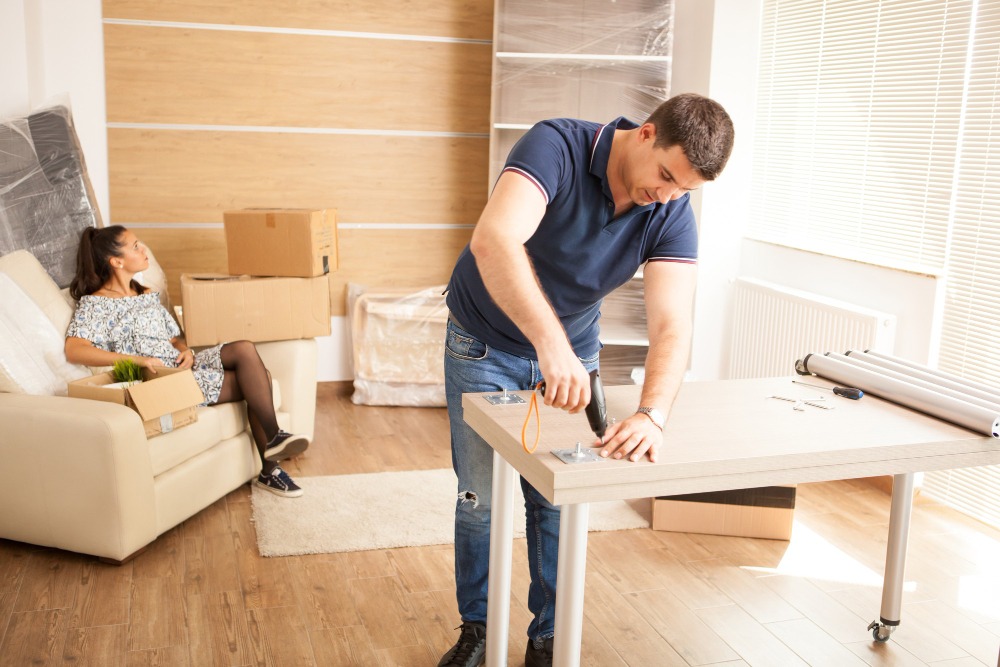Furniture serves as an essential aspect of our homes, providing comfort, functionality, and aesthetic appeal. Whether you’re dealing with a temporary living situation, downsizing, or simply looking to declutter, proper furniture storage is crucial to preserving the condition and longevity of your cherished pieces. This guide offers useful tips to help you navigate the process of storing furniture efficiently.

Assessing Furniture for Storage
Before stowing away furniture, it’s crucial to assess each piece to ensure it’s ready for storage. Start by cleaning and, if applicable, disassembling larger items to save space and prevent damage. Consider applying protective treatments, such as wax or polish, to wood surfaces. For upholstered furniture, use fabric protectors to shield against dust and potential stains during storage. Inspect each item for any existing damage, and document it to avoid confusion later. Properly preparing your furniture beforehand contributes to its longevity and maintains its condition while in storage.
Choosing the Right Storage Space
When it comes to storing your furniture, choosing the right storage space is a critical decision that directly impacts the well-being of your belongings. In Singapore, where space is often a premium, selecting storage space providers becomes essential. Opting for reputable providers of storage space in Singapore ensures that your furniture is housed in a secure, climate-controlled environment, safeguarding it against the region’s tropical climate and potential environmental challenges. Research and select storage spaces that offer reliable security measures, climate control, and convenient access, providing you with peace of mind and easy retrieval when needed.
Disassembly and Preparation
Disassembly and preparation are key steps in ensuring the safe storage of furniture. For larger pieces, such as sofas, tables, or bed frames, consider disassembling them to make transportation and storage more manageable. Keep track of all hardware, nuts, and bolts in labeled bags to simplify reassembly later. Securely wrap and protect individual components with appropriate materials, such as bubble wrap or furniture blankets, to prevent scratches or damage during the moving and storage process.
Additionally, take extra care with fragile items, like glass tabletops or intricate woodwork. Remove any detachable parts and wrap them separately, ensuring they are well-padded to avoid breakage. Label each component and package meticulously to streamline the reassembly process when the furniture is retrieved. Thorough disassembly and careful preparation contribute significantly to preserving the integrity of furniture during storage and ease the eventual setup when needed.
Proper Packaging and Labeling
Proper packaging and labeling are crucial aspects of ensuring the longevity and accessibility of stored furniture. Begin by selecting high-quality packing materials, such as sturdy cardboard boxes, bubble wrap, and packing tape. Wrap each furniture item securely to shield it from dust, dirt, and potential scratches. For upholstered furniture, consider using plastic covers to provide an additional layer of protection against moisture and pests.
Labeling is equally essential for efficient storage and retrieval. Clearly mark each box with its contents and, if applicable, the room it belongs to. Use labels or color-coded tags to categorize items based on their fragility or priority for access. This meticulous labeling system will not only streamline the organization of stored furniture but also make it easier to locate specific items when needed. Taking the time to package furniture appropriately and label thoughtfully contributes to a smooth storage experience and helps maintain the condition of your belongings.
Stacking and Arranging
When it comes to storing furniture, strategic stacking and arranging play a pivotal role in optimizing the use of space and ensuring the safety of your items. Begin by disassembling larger pieces whenever possible to reduce their footprint and make stacking more efficient. When stacking chairs or smaller items, place them seat to seat or surface to surface to minimize potential damage. Ensure that the heaviest items form the base of the stack, providing stability and preventing any crushing of more delicate pieces.
Consider the layout of your storage space and create aisles or walkways to facilitate easy access to each item. When stacking multiple boxes or pieces, leave clear pathways to prevent a cluttered and inaccessible storage unit. Additionally, avoid placing heavy items on top of more fragile ones to prevent breakage. Taking the time to plan the arrangement of your stored furniture will not only maximize the available space but also contribute to a well-organized and easily navigable storage area.
Security Measures
Implementing effective security measures is crucial when storing furniture to safeguard your valuable items. Opt for a storage facility that provides robust security features, such as surveillance cameras, secure access controls, and well-lit premises. Consider using sturdy locks for individual units to add an extra layer of protection. Additionally, inquire about the storage facility’s policies regarding insurance coverage and whether they offer any additional security services. Taking these precautions ensures that your furniture is stored in a secure environment, providing you with peace of mind throughout the storage period.
Regular Checkups and Maintenance
Regular checkups and maintenance are essential aspects of proper furniture storage. Periodically visit your storage unit to inspect the condition of your items and ensure they remain in good shape. Check for any signs of damage, pests, or environmental issues such as mold or mildew. If your storage facility offers climate-controlled units, confirm that the conditions are optimal for preserving the integrity of your furniture, especially if it includes sensitive materials like wood or upholstery.
In addition to physical inspections, consider rotating or shifting the position of your stored items during these visits. This helps prevent any long-term pressure on specific areas of furniture, reducing the risk of warping or distortion over time. If you notice any issues during your checkups, address them promptly. Regular maintenance not only ensures the longevity of your furniture but also allows you to take proactive measures to preserve its quality throughout the storage period.
Retrieval and Reassembly
Retrieving and reassembling furniture after a period of storage requires a systematic and careful approach. When you’re ready to bring your furniture back into use, start by creating an inventory list. This list should detail each item and its condition before storage, making it easier to track and account for all pieces during the retrieval process. As you retrieve each item, check it against the inventory to ensure nothing is missing or damaged.
During reassembly, follow any manufacturer’s instructions or guidelines you may have for specific pieces of furniture. Be cautious with fasteners, and use proper tools to avoid causing any unintended damage. If you disassembled furniture for storage, refer to any labeled parts or take note of the disassembly process you followed. This will simplify the reassembly and ensure that all components are correctly put back together. Taking the time to retrieve and reassemble your furniture thoughtfully will contribute to a smooth transition and help maintain the longevity and usability of your cherished pieces.

Properly storing furniture is an art that involves careful preparation, organization, and attention to detail. By following these tips, you can ensure that your furniture remains in optimal condition, ready to be enjoyed when it’s time to retrieve and reintegrate these cherished pieces into your living space. Whether you’re in transition or looking to declutter, maximizing your space through effective furniture storage will contribute to the longevity and beauty of your belongings.



